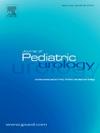Effect of enhanced recovery after surgery on postoperative outcomes in children undergoing robot-assisted laparoscopic pyeloplasty
IF 2
3区 医学
Q2 PEDIATRICS
引用次数: 0
Abstract
Objective
To assess the effects of the enhanced recovery after surgery (ERAS) perioperative protocol on the outcomes of robot-assisted laparoscopic pyeloplasty (RALP) in pediatric patients.
Methods
A total of 57 children who underwent RALP at our center between November 2021 and December 2023 were included in the study. They were randomly assigned to either the ERAS (intervention) group or the non-ERAS (control) group. The analysis focused on comparing the length of hospital stay, recovery of gastrointestinal function, incidence of complications within 90 days post-surgery, postoperative extubation time (urinary tube and double-J tube), postoperative auxiliary examinations, and readmission rates within 30 days. Additionally, the patients were divided into two age groups: <4 years old and ≥4 years old, to assess pain severity.
Results
There were no significant differences in preoperative general information, preoperative auxiliary examination findings, or intraoperative conditions between the ERAS and non-ERAS groups. The ERAS group had a significantly shorter postoperative hospital stay compared to the non-ERAS group. Furthermore, the time to the first postoperative bowel movement was shorter, and the incidence of postoperative complications was significantly lower in the ERAS group. Among children <4 years old, there was no significant difference in pain severity between the two groups. However, in children ≥4 years old, the ERAS group experienced significantly lower pain levels at 6 and 24 h post-surgery compared to the non-ERAS group.
Discussion
The findings of this prospective randomized controlled trial should determine if ERAS is superior to traditional perioperative management in children undergoing RALP, particularly regarding postoperative hospital stay, intestinal function recovery, pain response, and complication rates. We anticipate that our data will offer valuable clinical insights and guidance for the implementation of ERAS in pediatric robotic surgery for urinary diseases.
Conclusion
The ERAS protocol can reduce the length of hospital stay, aid in the recovery of gastrointestinal function, and lower postoperative complication rates. It also has the potential to lessen postoperative pain to varying degrees in certain pediatric patients. ERAS is a safe and effective protocol for pediatric patients undergoing RALP.
Summary Table. Postoperative hospital stay and gastrointestinal function recovery of the two groups.
| Postoperative condition | ERAS (n = 30) | non-ERAS (n = 27) | P Value |
|---|---|---|---|
| Length of hospital stay (d) | 2.0 (2.0–3.0) | 3.0 (3.0–6.0) | <0.001 |
| Time of first flatus (h) | 18.0 (10.5–24.0) | 27.6 (19.5–41.4) | 0.006 |
| Time of first defecation (h) | 23.8 (19.8–40.0) | 47.0 (27.7–53.0) | 0.002 |
P< 0.05 was statistically significant.
加强术后恢复对接受机器人辅助腹腔镜肾盂成形术的儿童术后效果的影响。
目的评估加强术后恢复(ERAS)围术期方案对机器人辅助腹腔镜肾盂成形术(RALP)儿科患者疗效的影响:研究共纳入了57名2021年11月至2023年12月期间在本中心接受RALP手术的儿童。他们被随机分配到ERAS(干预)组或非ERAS(对照)组。分析的重点是比较住院时间、胃肠功能恢复情况、术后 90 天内并发症发生率、术后拔管时间(尿管和双 J 管)、术后辅助检查和 30 天内再入院率。此外,患者还被分为两个年龄组:结果ERAS 组和非 ERAS 组在术前一般信息、术前辅助检查结果或术中情况方面没有明显差异。与非 ERAS 组相比,ERAS 组的术后住院时间明显更短。此外,ERAS 组患者术后首次排便的时间更短,术后并发症的发生率也明显更低。儿童 讨论:这项前瞻性随机对照试验的结果将确定 ERAS 是否优于传统的 RALP 儿童围手术期管理,尤其是在术后住院时间、肠道功能恢复、疼痛反应和并发症发生率方面。我们预计,我们的数据将为ERAS在小儿泌尿疾病机器人手术中的实施提供有价值的临床见解和指导:ERAS方案可以缩短住院时间,帮助恢复胃肠功能,降低术后并发症发生率。ERAS方案还能在不同程度上减轻某些儿童患者的术后疼痛。对于接受 RALP 的儿童患者来说,ERAS 是一种安全有效的方案。
本文章由计算机程序翻译,如有差异,请以英文原文为准。
求助全文
约1分钟内获得全文
求助全文
来源期刊

Journal of Pediatric Urology
PEDIATRICS-UROLOGY & NEPHROLOGY
CiteScore
3.70
自引率
15.00%
发文量
330
审稿时长
4-8 weeks
期刊介绍:
The Journal of Pediatric Urology publishes submitted research and clinical articles relating to Pediatric Urology which have been accepted after adequate peer review.
It publishes regular articles that have been submitted after invitation, that cover the curriculum of Pediatric Urology, and enable trainee surgeons to attain theoretical competence of the sub-specialty.
It publishes regular reviews of pediatric urological articles appearing in other journals.
It publishes invited review articles by recognised experts on modern or controversial aspects of the sub-specialty.
It enables any affiliated society to advertise society events or information in the journal without charge and will publish abstracts of papers to be read at society meetings.
 求助内容:
求助内容: 应助结果提醒方式:
应助结果提醒方式:


